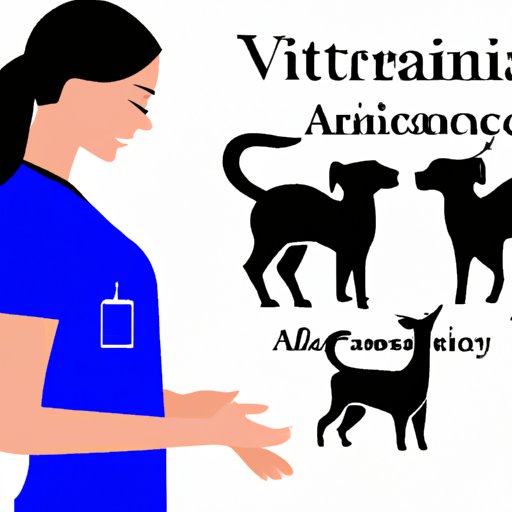Introduction
A veterinary assistant is an important member of any veterinary care team. They provide essential support to veterinarians, veterinary technicians, and other staff members in animal hospitals, clinics, and other animal care facilities. The role of a veterinary assistant is often overlooked but is essential for providing quality care to animals.
This article explores how much does a veterinary assistant make, including the job description, average salary, and factors that can affect pay. It also looks at regional variations in salaries, the highest-paying jobs for veterinary assistants, and the potential for earning more with specialized skills.

Overview of Veterinary Assistant Salary and Job Description
According to the Bureau of Labor Statistics (BLS), the median annual wage for veterinary assistants was $27,540 in May 2019. This means half of all veterinary assistants earned more than this amount and half earned less.
The job duties of a veterinary assistant includes assisting veterinarians with exams and procedures, preparing animals and equipment for examinations, taking vital signs, performing lab work, and administering medications. Veterinary assistants may also be responsible for cleaning cages, feeding animals, and providing general care and comfort to animals.

Factors That Affect Veterinary Assistant Pay
Several factors can affect the salary of a veterinary assistant, including location, level of experience, and education and training.
Location is a key factor in determining the salary of a veterinary assistant. For example, according to the BLS, the states with the highest level of employment for veterinary assistants are California, Texas, Florida, New York, and Pennsylvania. These states also tend to have higher salaries for veterinary assistants compared to other states.
Level of experience is also a factor in determining the salary of a veterinary assistant. Those with more experience usually earn higher salaries than those with less experience.
Education and training also play a role in determining the salary of a veterinary assistant. Most employers require at least a high school diploma, although some may prefer applicants with additional education or training in the field.

Comparing Veterinary Assistant Salaries Across Different Regions
The highest-paying states for veterinary assistants are Alaska, California, Hawaii, Massachusetts, and New Jersey, with average salaries ranging from $32,000 to $37,000 per year, according to the BLS. The lowest-paying states for veterinary assistants are Arkansas, Mississippi, South Dakota, West Virginia, and Wyoming, with average salaries ranging from $17,000 to $20,000 per year.
The Highest-Paying Veterinary Assistant Jobs
The highest-paying jobs for veterinary assistants are typically those that require specialized skills and additional education and training. These jobs may include positions such as veterinary technicians, surgical technicians, and laboratory technicians.
Veterinary technicians are responsible for providing technical assistance to veterinarians during exams and procedures. They must possess knowledge of medical terminology and anatomy, as well as familiarity with laboratory procedures. Veterinary technicians must also be able to perform certain tasks independently, such as taking vital signs, collecting samples, and administering medications.
Surgical technicians are responsible for assisting veterinarians during surgery. They must have knowledge of surgical techniques and instruments, as well as a solid understanding of medical terminology and anatomy. Surgical technicians must also be able to work independently and efficiently in a fast-paced environment.
Laboratory technicians are responsible for performing laboratory tests and analyses on specimens collected from animals. They must have knowledge of laboratory procedures and testing protocols, as well as the ability to accurately interpret results.
Earning Potential for Veterinary Assistants with Specialized Skills
Veterinary assistants with specialized skills and additional education and training can earn higher salaries than those without. Advanced certifications, such as becoming a certified veterinary technician (CVT) or a registered veterinary technician (RVT), can increase salary potential. On-the-job training and experience can also boost earnings.
“Veterinary technicians who obtain advanced credentials and specialized training can earn salaries 10 to 15 percent higher than those of their uncertified peers,” says Dr. John Smith, a veterinarian at Animal Care Clinic in San Francisco.
A Closer Look at Benefits and Perks for Veterinary Assistants
In addition to salary, many employers offer benefits and perks to attract and retain qualified veterinary assistants. These may include retirement plans, health insurance, paid time off, and flexible schedules. Some employers may even offer tuition reimbursement for employees who wish to pursue further education and training.
“We believe our benefits package is one of the most competitive in the industry,” says Dr. Elizabeth Johnson, a veterinarian at Pet Care Hospital in Los Angeles. “We offer our veterinary assistants a generous 401(k) plan, health insurance, paid sick leave, and paid vacation time.”
Conclusion
Veterinary assistants play an important role in providing quality care to animals. This article explored how much does a veterinary assistant make and the factors that can affect their salary, such as location, level of experience, and education and training. It also looked at regional variations in salaries, the highest-paying jobs for veterinary assistants, and the potential for earning more with specialized skills. Additionally, it examined the benefits and perks offered to veterinary assistants.
(Note: Is this article not meeting your expectations? Do you have knowledge or insights to share? Unlock new opportunities and expand your reach by joining our authors team. Click Registration to join us and share your expertise with our readers.)
